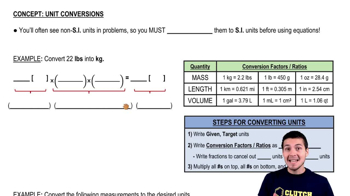Unit Conversions definitions Flashcards
 Back
BackUnit Conversions definitions
1/15
Terms in this set (15)
- SI systemA standardized system of units used globally in science and industry, ensuring compatibility and consistency in measurements.
- Non-SI unitsUnits not part of the International System of Units, often requiring conversion for scientific calculations.
- Conversion factorA ratio expressed as a fraction that relates two different units, used to convert measurements.
- Conversion ratioAnother term for conversion factor, emphasizing its expression as a fraction to facilitate unit conversion.
- Metric prefixesPrefixes that denote powers of ten, used to express multiples or fractions of units in the metric system.
- KilogramThe base unit of mass in the SI system, equivalent to 1000 grams.
- PoundA unit of mass in the imperial system, often converted to kilograms in scientific contexts.
- Miles per hourA unit of speed expressing the number of miles traveled in one hour, often converted to meters per second.
- Meters per secondThe SI unit of speed, representing the distance in meters traveled in one second.
- Feet squaredA unit of area in the imperial system, often converted to meters squared in scientific calculations.
- Meters squaredThe SI unit of area, representing a square with sides of one meter each.
- ExponentA mathematical notation indicating the number of times a unit is multiplied by itself.
- NumeratorThe top part of a fraction, representing the number of parts considered.
- DenominatorThe bottom part of a fraction, representing the total number of equal parts.
- Canceling unitsA method in unit conversion where units in the numerator and denominator are eliminated to simplify calculations.

